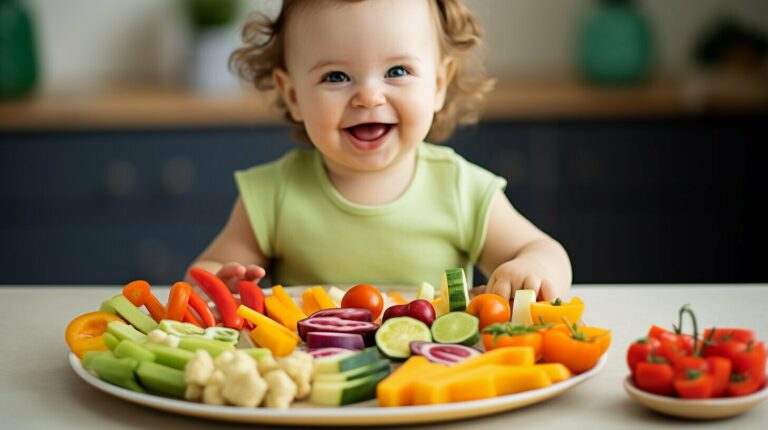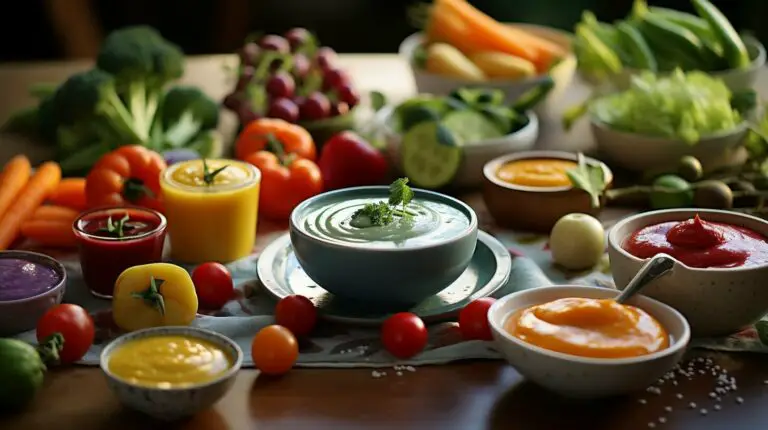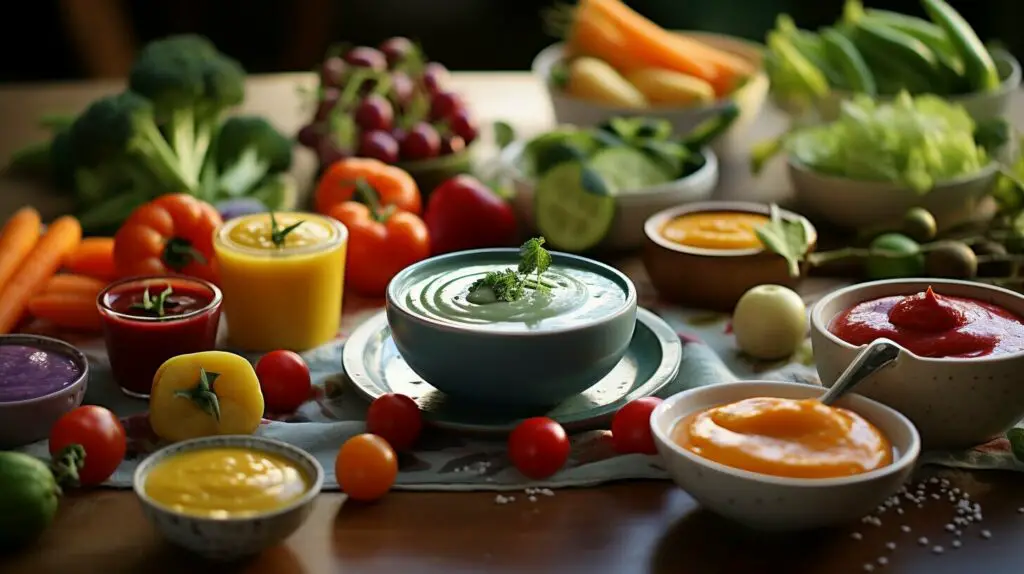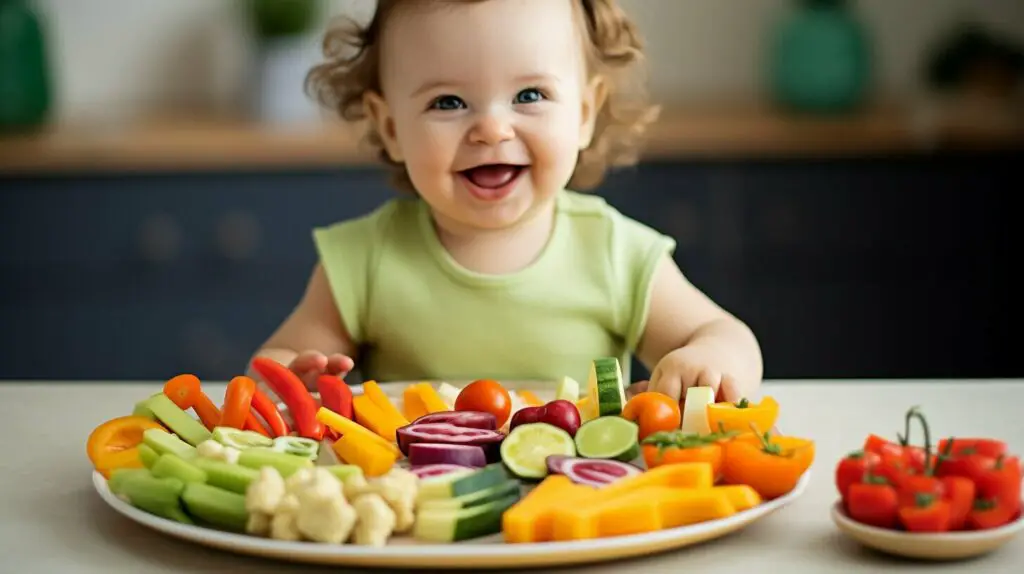Introducing your baby to solid foods is a major milestone, and one that should be celebrated. Baby led weaning, or allowing your baby to self-feed, is gaining popularity among parents. Not only is it a fun and messy experience for your little one, but it can also have numerous benefits.
When should you start baby led weaning? The American Academy of Pediatrics recommends starting around 6 months of age when your baby shows signs of readiness, such as being able to sit up unassisted and bringing objects to their mouth. But what are the different stages of baby led weaning and what are some safe finger foods for your baby at different ages?
We’ve got you covered. Read on for tips on how to prevent choking during baby led weaning, and how to make it a success.

Key Takeaways:
- Baby led weaning involves allowing your baby to self-feed and can have numerous benefits.
- You can start baby led weaning at around 6 months of age when your baby shows signs of readiness.
- There are different stages of baby led weaning, and you can gradually introduce more challenging textures.
- Prevent choking during baby led weaning by offering appropriate food sizes, supervising meal times, and being prepared to handle choking emergencies.
- Make baby led weaning a success by creating a safe feeding environment, involving your baby in family meals, and allowing them to explore a variety of textures and flavors.
- Stay tuned for some delicious baby led weaning recipes suitable for babies aged 6 to 9 months.
When to Start Baby Led Weaning
Are you wondering when it is appropriate to start baby led weaning? Typically, babies are ready to start at around 6 months of age when they show signs of readiness such as being able to sit up unassisted and bring objects to their mouth. It is important to speak with your pediatrician before starting to ensure your baby is ready.
Starting too early could increase the risk of choking, and starting too late could lead to developmental delays. By waiting until your baby is ready, you can help ensure a smooth transition to solid foods.
Remember, every baby is different, and some may not be ready until closer to 7 or 8 months of age. Trust your instincts and consult with your healthcare provider if you have any concerns.
Different Stages of Baby Led Weaning
During baby led weaning, you will be introducing your little one to a variety of foods with different textures and flavors. It is important to start with softer foods that your baby can easily grab and feed themselves.
As your baby gets used to self-feeding, you can gradually increase the texture and size of the food pieces. This will help them develop their chewing skills and get used to different tastes and textures.
The stages of baby led weaning can be broken down into:
- Introduction Stage: Start with softer foods such as ripe bananas or steamed carrots that can be easily mashed or squished.
- Transition Stage: After your baby has successfully managed the introduction stage, they can move on to slightly firmer foods such as steamed broccoli or cooked pasta pieces.
- Foods with Stronger Flavors: Once your baby is comfortable with different textures, you can introduce foods with stronger flavors such as garlic or spices, to get them used to different tastes.
- Finger Food Stage: By this stage, your baby should be able to pick up and handle finger foods like toast or crackers without assistance, which helps to develop their fine motor skills.
As your baby graduates through the different stages of baby led weaning, you can offer more complex foods that require more chewing, such as grilled chicken or roasted vegetables.
Remember to always supervise your baby during feeding times and be prepared to handle any choking emergencies. If you have any concerns about your baby’s readiness for baby led weaning or their overall health, consult with your pediatrician.
Safe Finger Foods for 6-Month-Olds
Introducing solid foods is an exciting milestone for babies and parents alike, but it’s essential to ensure that your little one is safe while exploring new tastes and textures. When it comes to baby-led weaning, safety is a top priority, so it’s important to know which foods are safe for your 6-month-old.
At this stage, your baby’s digestive system is still developing, so it’s important to offer soft, easily digestible foods. Here are some finger foods that are safe and appropriate for 6-month-olds:
| Safe Finger Foods for 6-Month-Olds | How to Prepare |
|---|---|
| Soft fruits, such as bananas, peaches, and ripe pears | Peel and cut into small, bite-sized pieces |
| Cooked and mashed sweet potatoes or squash | Cook until tender, mash or cut into small pieces |
| Well-cooked and finely shredded chicken or other meat | Cook until tender, shred into small pieces |
| Soft-cooked vegetables, such as carrots and green beans | Cook until tender, cut into small, bite-sized pieces |
| Unsweetened baby cereal | Mix with breast milk, formula, or water to create a thick consistency |
When preparing finger foods for your 6-month-old, it’s important to ensure that they are cut into appropriate sizes to avoid choking hazards. Always supervise meal times and be prepared to handle a choking emergency in case it arises. Remember, every baby is different, so go at their pace and offer a variety of tastes and textures to promote their exploration and enjoyment of food.
Safe Finger Foods for 9-Month-Olds
As your baby grows and becomes more skilled with self-feeding, you can offer a wider variety of finger foods, including those with a more challenging texture. Here are some safe and nutritious finger foods for 9-month-olds:
| Food | Preparation |
|---|---|
| Soft fruits (such as bananas, peaches, and melons) | Cut into small pieces or slices, removing any seeds or pits |
| Cooked vegetables (such as sweet potatoes, carrots, and broccoli) | Cut into small pieces or mash with a fork |
| Cheese | Cut into small cubes or shreds |
| Well-cooked pasta | Cut into small pieces or use as spirals or shells |
| Cooked legumes (such as lentils and chickpeas) | Mash or cut into small pieces |
| Small pieces of soft cooked meats (such as chicken or beef) | Cut into small pieces or shreds |
| Greek Yogurt | Plain Greek Yogurt, serve with a small spoon |
Remember to always supervise your baby during meal times, and cut food into appropriate sizes to avoid choking hazards. Offer a variety of colors, textures, and flavors to encourage your baby’s curiosity and interest in food.
Before starting baby led weaning, it is always important to discuss the best practices for safe and healthy feeding with your pediatrician. Enjoy your baby’s journey to discovering new tastes and textures!
How to Prevent Choking during Baby Led Weaning
Preventing choking is a top concern for parents who are introducing their babies to solid foods through the baby led weaning method. Here are some tips to help you prevent choking:
- Offer age-appropriate finger foods that are soft and easy to chew, such as avocado and well-cooked vegetables.
- Avoid giving small, hard, or round foods that can be easily lodged in your baby’s throat, such as nuts, popcorn, and grapes.
- Be present and supervise your baby during meal times to ensure they are safely chewing and swallowing their food.
- Take a CPR class as an extra precaution.
- Understand the signs of choking and learn how to respond quickly in case it occurs.
Remember, baby led weaning encourages your baby to self-feed and explore new textures at their own pace. While it may seem scary at first, the benefits to your baby’s long-term health and development are significant. By following these tips, you can help ensure your baby has a safe and positive experience with baby led weaning.
Tips for Making Baby Led Weaning a Success
Starting baby led weaning can be exciting and overwhelming at the same time. Here are some tips to help make the process a success:
- Start with soft and easy to handle foods, such as cooked vegetables or ripe fruits.
- Create a safe feeding environment. Make sure your baby is seated upright and secure in their high chair, and avoid distractions like TV or phones.
- Involve your baby in family meals. Your baby will learn from watching you eat and will feel included in mealtime.
- Be patient with the mess. Your baby will explore their food and may drop or smear it around. This is part of the process and helps them learn about food textures and colors.
- Offer a variety of foods with different flavors and textures. This will help your baby develop a diverse palate and prevent picky eating habits.
Remember, every baby is unique and will progress through the weaning process at their own pace. Be supportive and follow your baby’s lead.
Baby Led Weaning Recipes for 6 to 9 Months Old
Introducing your baby to solid foods is an exciting milestone, and baby led weaning is a great way to do it. Here are some delicious baby led weaning recipes that are healthy and easy to prepare for your little one aged 6 to 9 months old.
1. Avocado and Banana Mash
Avocado and banana are both great first foods for babies. This delicious mash is packed with healthy fats, fiber, and vitamins.
Ingredients:
- 1 ripe avocado
- 1 ripe banana
Instructions:
- Peel and mash the avocado and banana together until smooth.
- Feed it to your baby using a spoon or let them self-feed with their fingers.
2. Carrot and Sweet Potato Fries
These oven-baked fries are a great finger food for babies who are learning to self-feed. The orange vegetables are also rich in vitamin A, which is important for healthy eyesight.
Ingredients:
- 1 large sweet potato, peeled and cut into thin fries
- 2 large carrots, peeled and cut into thin fries
- 1 tablespoon olive oil
- Pinch of salt (optional)
Instructions:
- Preheat oven to 400°F (200°C) and line a baking sheet with parchment paper.
- In a mixing bowl, toss the sweet potato and carrot fries with olive oil and salt (optional).
- Spread the fries out on the prepared baking sheet in a single layer.
- Bake for 20-25 minutes or until crispy, stirring occasionally.
- Allow the fries to cool down before serving them to your baby.
3. Chicken and Apple Balls
These tasty balls are a great source of protein and iron for your baby, and the sweet apple adds a delicious flavor.
Ingredients:
- 1 boneless and skinless chicken breast, cooked and shredded
- 1 apple, peeled and grated
- 3 tablespoons breadcrumbs
- 1 small egg, beaten
- 1 tablespoon olive oil
Instructions:
- In a mixing bowl, combine the shredded chicken, grated apple, breadcrumbs, and beaten egg.
- Form the mixture into small balls using your hands.
- In a frying pan, heat the olive oil over medium heat.
- Cook the chicken and apple balls for 8-10 minutes, turning occasionally, until golden brown and cooked through.
- Allow the balls to cool down before serving them to your baby.
These baby led weaning recipes are just a starting point. Feel free to experiment with different flavors and textures to find what your baby likes best. Remember to always supervise your baby during mealtimes and consult with your pediatrician before starting any new foods.
You may also like to read:
Grid
Wholesome Vegan Baby Led Weaning Recipes for Little Eaters
Delicious Baby Led Weaning Recipes for the Whole Family
Baby Led Weaning vs Traditional Weaning: A Comprehensive Guide
Easy and Nutritious Dairy Free Baby Led Weaning Recipes
Delicious Egg Free Baby Led Weaning Recipes for Your Little One
What to Expect When Weaning Off Breastfeeding: A Practical Guide
Benefits of Baby Led Weaning
There are numerous benefits to introducing your baby to solid foods through baby led weaning. Here are some of the key benefits:
- Encourages self-feeding skills: Baby led weaning encourages babies to explore and learn to self-feed, which can help develop important dexterity skills.
- Promotes a varied diet: Offering a wide variety of flavors and textures can help expand your baby’s palate and encourage them to try new foods.
- Improves hand-eye coordination: Babies who practice baby led weaning have the opportunity to work on their hand-eye coordination as they pick up and explore different foods.
- Fosters positive relationship with food: Baby led weaning encourages babies to explore and enjoy a variety of foods, which can help develop a positive relationship with food and reduce the likelihood of picky eating.
- Encourages family meals: Baby led weaning encourages participation in family meals, which can help babies learn about different foods and socialize with others.
It’s important to discuss baby led weaning with your pediatrician to determine if it’s the right approach for your baby, and to get guidance on how to get started.
Baby Led Weaning: Introducing Your 6 to 9-Month-Old to Solid Foods
As your baby grows, so does their appetite for new and exciting flavors and textures. Baby led weaning is a popular and beneficial feeding method that emphasizes self-feeding and exploration of food. If you’re considering baby led weaning, here’s what you need to know to get started.
When to Start Baby Led Weaning:
Baby led weaning is typically introduced around 6 months of age when your baby shows signs of readiness such as being able to sit up unassisted and showing interest in food. However, it’s important to consult with your pediatrician before starting to ensure it’s appropriate for your child.
Different Stages of Baby Led Weaning:
Baby led weaning involves gradually introducing your baby to different textures, starting with softer foods and progressing to more challenging textures. It’s important to allow your baby to explore at their own pace and avoid rushing the process.
Safe Finger Foods for 6-Month-Olds:
When first introducing finger foods to your 6-month-old, stick to soft fruits, cooked vegetables, and small pieces of well-cooked meats. Be sure to avoid choking hazards by cutting food into appropriate sizes and supervising meal times.
Safe Finger Foods for 9-Month-Olds:
As your baby approaches 9 months, you can introduce larger chunks of fruits and vegetables, small pieces of pasta, and cheese. Offer a variety of textures and flavors to encourage exploration.
How to Prevent Choking during Baby Led Weaning:
Preventing choking during baby led weaning involves offering appropriate food sizes, supervising meal times, and being prepared to handle choking emergencies. Consider taking a CPR course for parents and caregivers for added peace of mind.
Tips for Making Baby Led Weaning a Success:
Create a safe feeding environment, involve your baby in family meals, and be patient with
the mess. Encourage exploration and offer a variety of flavors and textures to promote a positive relationship with food.
Baby Led Weaning Recipes for 6 to 9 Months Old:
Try these delicious and nutritious baby led weaning recipes suitable for babies aged 6 to 9 months. From fruity purees to savory finger foods, these recipes will have your little one exploring new flavors and textures in no time.
- Avocado and Banana Mash
- Ingredients:
- 1 ripe avocado
- 1 ripe banana
- Instructions:
- Peel and mash the avocado and banana together until smooth.
- Feed it to your baby using a spoon or let them self-feed with their fingers.
- Carrot and Sweet Potato Fries
- Ingredients:
- 1 large sweet potato, peeled and cut into thin fries
- 2 large carrots, peeled and cut into thin fries
- 1 tablespoon olive oil
- Pinch of salt (optional)
- Instructions:
- Preheat oven to 400°F (200°C) and line a baking sheet with parchment paper.
- In a mixing bowl, toss the sweet potato and carrot fries with olive oil and salt (optional).
- Spread the fries out on the prepared baking sheet in a single layer.
- Bake for 20-25 minutes or until crispy, stirring occasionally.
- Allow the fries to cool down before serving them to your baby.
- Chicken and Apple Balls
- Ingredients:
- 1 boneless and skinless chicken breast, cooked and shredded
- 1 apple, peeled and grated
- 3 tablespoons breadcrumbs
- 1 small egg, beaten
- 1 tablespoon olive oil
- Instructions:
- In a mixing bowl, combine the shredded chicken, grated apple, breadcrumbs, and beaten egg.
- Form the mixture into small balls using your hands.
- In a frying pan, heat the olive oil over medium heat.
- Cook the chicken and apple balls for 8-10 minutes, turning occasionally, until golden brown and cooked through.
- Allow the balls to cool down before serving them to your baby.
These baby led weaning recipes are just a starting point. Feel free to experiment with different flavors and textures to find what your baby likes best. Remember to always supervise your baby during mealtimes and consult with your pediatrician before starting any new foods.
Conclusion
Baby led weaning is a wonderful way to introduce your baby to solid foods while promoting exploration and self-feeding skills. Remember to consult with your pediatrician before starting and always supervise meal times to prevent choking. With a little patience and creativity, you and your baby can enjoy a variety of delicious and nutritious foods together.
FAQs (Frequently Asked Questions)
1. Is baby led weaning safe for all babies?
- Baby led weaning can be safe for most babies, but it’s important to consult with your pediatrician to ensure it’s appropriate for your child’s specific developmental stage and needs.
2. What are some signs that my baby is ready for baby led weaning?
- Signs of readiness include being able to sit up unassisted, showing interest in food, and having good head and neck control.
3. Are there any foods I should avoid during baby led weaning?
- Yes, avoid foods that are choking hazards, such as small, hard, or round foods like nuts, popcorn, and grapes. Be cautious with foods that can cause allergies and introduce them one at a time.
4. How can I encourage my baby to try new foods during baby led weaning?
- Offer a variety of flavors and textures, involve your baby in family meals, and be patient with their exploration. Encourage them to touch, taste, and play with their food.
5. What should I do if my baby chokes during baby led weaning?
- Take a CPR class for infants and be prepared to respond quickly. If your baby chokes, follow the appropriate choking response techniques you learned in the class.
6. Can I combine baby led weaning with traditional spoon-feeding methods?
- Yes, you can combine both methods to cater to your baby’s needs and preferences. The key is to ensure that the foods you offer are appropriate for your baby’s developmental stage.
Remember that every baby is unique, and it’s essential to adapt your approach to fit your child’s individual needs and preferences. Enjoy the exciting journey of introducing your baby to the world of solid foods through baby led weaning!










